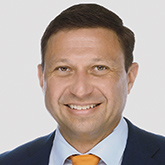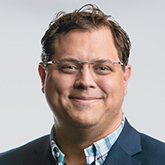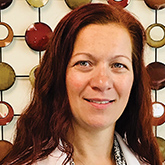Leveraging data & technology for transformative healthcare solutions
Technology is driving change across all sectors, including healthcare. Data, artificial intelligence (AI) and machine learning offer opportunities for healthcare innovators to tackle industry challenges, improve patient care, streamline clinical processes and usher in the future of healthcare.
Getting the right team together

One such innovator is Michael Schlosser, M.D., MBA, SVP of HCA Healthcare’s Department of Care Transformation and Innovation (CT&I). Launched in 2021, CT&I has grown to approximately 650 colleagues encompassing data science, clinical informatics, Expanse EHR, Accelerated Technologies and its Start-up CT&I team (clinical, data science, technology, operations, change management and finance leaders), with the goal of digital transformation. The combined strength of this team is supported internally by a Transformation Advisory Board of HCA Healthcare leaders and care staff, and also partners with third-party technology companies.
“We knew we needed a team dedicated to innovation and this transformational work to leverage data and technology to redesign care and address complex challenges,” says Dr. Schlosser. “Today, we’re excited to consolidate the collective strength of these teams to drive transformation and innovation for our patients, care team members and the organization as a whole.”
In order to truly transform care delivery, Dr. Schlosser believes it’s important to avoid just layering technology on top of existing processes, which often creates more work for clinicians and healthcare workers. Instead, they look to embed technology into the workflow and remodel processes from top to bottom, using what they call “clinically led integration of technology into care.”
“Clinical input comes first,” explains Dr. Schlosser. “We work directly with our frontline care teams—the people who will be using this technology—and identify the problems and challenges they’re facing and ask how they think it could be done better.”
Designing solutions
Using these insights, the CT&I team can get to work designing solutions, working alongside frontline staffers in innovation hub hospitals to implement the solutions. Two facilities within HCA Healthcare serve as innovation hubs—TriStar Hendersonville Medical Center in Tennessee and UCF Lake Nona Hospital in Florida. They are serving as testing grounds where clinicians and hospital leaders are committed to furthering the CT&I mission.
CT&I is focused on identifying, developing, deploying and accelerating scalable, innovative, transformative data-driven and insight-generating technology solutions to improve the experience for both patients and care teams. The first challenge CT&I set its sights on was to reduce administrative burden from care team members, reducing time at the keyboard and increasing time with the patient. According to HCA Healthcare’s research, its physicians and other clinicians spend between 30% and 50% of their time on administrative tasks. This has implications not only for patient care but also staff satisfaction—and burnout.

One such solution is Timpani℠, HCA Healthcare’s automated scheduling and staffing solution, currently in place at 50 HCA Healthcare hospitals with more scheduled to be added in 2024. The CT&I team and partner Palantir developed Timpani to address longstanding industry-wide staffing issues. The platform reduces the average amount of planning time a nurse leader needs to produce the monthly schedule (from 15 hours down to three, on average) and uses machine learning to predict patient volume and staffing needs, then optimizes staffing based on staff proficiencies and schedule preferences. By elevating the voices of nursing leaders in building Timpani, the schedule meets their needs and enables them to better support care team members in serving patients.
Technologies such as AI and machine learning also offer opportunities to address billing challenges.
“Coding and billing can largely be automated, making things much more efficient; patients are not overbilled inappropriately, and physicians are optimizing their billing—as is the facility—for the care that’s provided,” says HealthTrust Physician Advisor Jeffrey Carter, M.D., Medical Director of the Burn Center at University Medical Center New Orleans. “We went through our facility recently and found that we were missing about 30% of our charges when there was no AI involved in our billing. That means I could hire another doctor or two if I just had better billing.”
The University of Pittsburgh Medical Center (UPMC) is implementing an AI solution developed by a UPMC team member to tackle the documentation burden clinicians face.

“The technology listens to conversations between a physician and the patient,” says HealthTrust Physician Advisor Genevieve Everett-Sigwalt, M.D., a cardiac electrophysiologist at UPMC. “It’s not just a voice recognition software that generates a word-for-word dictation, but an AI-driven product that looks at that information and organizes it into a SOAP (Subjective, Objective, Assessment and Plan) note, putting a patient’s symptoms in a category with the history of current illnesses and so on. It’s organizing data as the hospital or office encounter is occurring.”
In the past, Dr. Everett-Sigwalt would pull information from previous notes and electronic records, then type or use voice recognition software to capture her recollection of her conversation with the patient and manually create a SOAP note.
“The idea is to eliminate some of that process and save time. It’s almost like having a personal scribe, which not only saves time but also improves accuracy. Otherwise, if a provider is trying to have a conversation with the patient while also taking notes and placing orders, certain details may get lost, forgotten or not included in the final medical record,” she explains.
This technology is only used with patients’ permission, but Dr. Everett-Sigwalt says that so far, all of her patients have accepted it. Soon, the data will also be integrated into the hospital’s EMR (electronic medical record) software.
New ways to work with data
Integrating AI into patient documentation doesn’t just save time and improve accuracy at the collection point. It can also aid clinicians in data retrieval and analysis, helping them deal with the large quantities of information they often face.

“Data that is important to me as an anesthesiologist is going to be different than the information that’s of interest to a surgeon, medical doctor or other specialist,” adds HealthTrust Physician Advisor Christopher Page, M.D., a private practice anesthesiologist. “I like the idea of AI being a co-intelligence to humans and processing information to make it more useful or at least streamline it so I can focus on the patient care aspect that is important to me.”
At the Burn Center within the University Medical Center New Orleans, teams are using AI and deep learning to manipulate and analyze data contained in their patient and clinical registries. “It’s become much more user-friendly,” says Dr. Carter. “In the past, you practically had to be a data scientist to access information from the registry for injury prevention and educational outreach to communities and high-risk populations. The lag time for accessing the data was enormous. It was challenging to do any kind of performance improvement or engagement and see a change.”
For example, with these new data capabilities, they were able to identify that many burn and blast patients coming to them in mass casualty incidents had only minor injuries, burdening emergency departments with injuries that could be treated in the field. However, paramedics are not usually equipped with the supplies they need to provide that level of care.
“We worked with the state and developed small kits to go in helicopters and ambulances,” explains Dr. Carter. “This enables field-based caregivers to treat patients with minor injuries by irrigating a wound and putting a cooling gel on it to reduce pain—so hospital resources can stay focused on treating patients with more severe injuries.”
Using AI to aid diagnosis
Long QT syndrome (LQTS), a genetic disorder that can cause dangerous ventricular arrhythmias, can be challenging to diagnose.
Genetic testing is one way to diagnose LQTS, but because only a small number of genes have been identified for it, success has been limited.
“Even with having a handful of known genetic codes that identify patients who have long QT, you’re still going to end up missing some or diagnosing others with long QT but not knowing what their risk of having an arrhythmia is,” explains Dr. Everett-Sigwalt.
Researchers are using artificial intelligence and machine learning to process large numbers of EKGs and longer-term heart monitoring data to find patterns and make predictions to aid in the diagnosis of LQTS.
“We’re pursuing this avenue of looking at EKGs with AI to analyze that data to understand the behavior of this electrical activity in the heart to better determine who truly has this disorder and what their risk factors are,” says Dr. Everett-Sigwalt.
Intentional change
“Not all innovation is progress,” warns Dr. Page, quoting a favorite book. Recognizing which new technologies or solutions will lead to a substantial improvement—or, better yet, transformational change—is key. “We have to pick out the things that are most likely to be real improvements, not just marginal differences. It might be a shiny new object, but it’s not necessarily something that improves care.”
In HCA Healthcare’s CT&I team, they are intentional with the changes they make. Not only does this help shield them from the latest and greatest “shiny objects,” but it also makes implementing change easier. The healthcare industry has traditionally been known for its slow adoption of change—understandable when new ways of delivering care could potentially harm patients.
“When we ask our clinicians to change, we’re intentional about it. We make sure to understand their concerns and develop strategies to mitigate any resistance,” says Dr. Schlosser. “We believe this multidisciplinary approach—focused on change management, the end user and leveraging technology—is an effective formula to bring about digital transformation in our hospitals that enable our teams to provide the highest quality of care.”
Your turn: Share how artificial intelligence is transforming clinical practice or business processes and performance at your organization by emailing thesource@healthtrustpg.com or posting on the HealthTrust Huddle.
Share Email AI, Diagnostics, Information Technology, Innovation, Q3 2024




